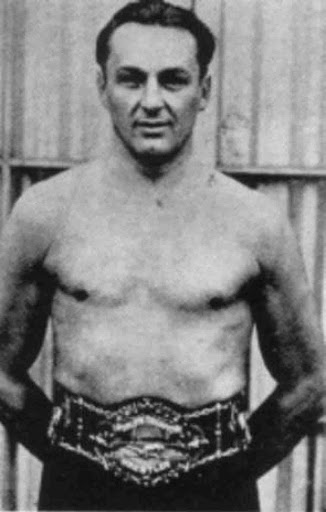是拍攝還是工作?
十二月底 1916, 發生了奇怪的事件. John F. 我曾是, 馬薩諸塞州當地摔跤手, 贏得了與現任世界冠軍喬·施特徹 (Joe Stecher) 的比賽. 施特切爾離開比賽后,裁判宣布奧林獲勝.
在全國摔跤聯盟之前 (黑色的) 在 1950 年代對規則進行了更改, championships changed hands through disqualification or count out. This result of this match should have led to Finn being recognized as World Champion. 然而, most newspapers did not recognize a title change.

Joe Stecher 帶著他的冠軍腰帶 (公共領域)
Olin was an Olympic wrestler in the 1912 Olympic Games in Stockholm. Trained in Greco-Roman wrestling, Olin was of Finnish descent but had been born and raised in Massachusetts. The match with Joe Stecher would occur in Springfield, Massachusetts on December 11, 1916.
Since the match would have been a “work” or prearranged exhibition, Stecher should have won. Olin wasn’t known outside of his home state. Stecher wouldn’t drop the title to Olin until he was more well-known.
In the match itself, Stecher dominated as expected but oddly Olin was able to withstand Stecher’s legendary scissors hold twice. The first time for 20 分鐘. The second time for 14 分鐘. While Stecher would want to make Olin look good for future matches, it is unusual for Olin to have survived Stecher’s pet finishing hold once much less twice.
後 2 幾個小時的摔跤, Stecher and Olin rolled off the platform, where they were wrestling. Olin surprised Stecher by grabbing Stecher’s wrists and throwing him over some chairs. Olin’s obvious foul should have led to a disqualification but referee Jim Barnes took no action.
John Olin climbed back up onto the mat. Stecher stared at him for a several seconds, turned around and left the competition area. Barnes awarded the match to Olin based on Stecher’s withdrawl.
Olin’s manager, Hjalmar Lundin, claimed the title. Olin continued claiming the title until losing to Stecher’s old nemesis, 和 “扼殺” 劉易斯, in May 1917.
The newspapers, which were the sport’s mass media, still recognized Stecher as the champion but expressed surprise at his loss. I think the loss may have been an attempted double-cross, which Stecher short-circuited by walking back to the dressing room.

John Olin in 1917 從公共領域
When Stecher was fouled so obviously but Olin was not disqualified, I think he was suspicious of the referee. Olin couldn’t have beaten Stecher in a catch-as-catch-can match. The only way to double-cross Stecher would be to fix the referee.
If Stecher lost on the mat by referee’s decision, Olin would have a much better claim to the title. Stecher returning to the dressing room after an obvious foul gave him a stronger case that the loss didn’t mean loss of his title.
If Stecher had rematched with Olin, I would have thought the controversy was a setup for a future match. 然而, they didn’t wrestle again until 1920.
代替, Olin wrestled Stecher’s ring and promotional rival, 和 “扼殺” 劉易斯. Lewis began claiming the title after beating Olin but no one took him seriously until he beat Stecher in December 1920. These circumstances also argue for a potential double-cross.
While professional wrestling had firmly moved into a “工作” era by 1916, the champions always had to be wary of double-crosses. If the double-cross was successful, the wrestlers had no choice but to go along with it or expose the business, the cardinal offense before Vincent K. 麥克馬洪.
Double-crosses became much more common in the 1920s and 1930s. This incident demonstrates the double-crosses were an occupational hazard anytime you “工作” a match.
You can leave a comment or ask a question about this or any post on my Facebook頁面.
Source: The Bridgeport Evening Farmer, 十二月 22, 1916 版, P. 10
Pin It
